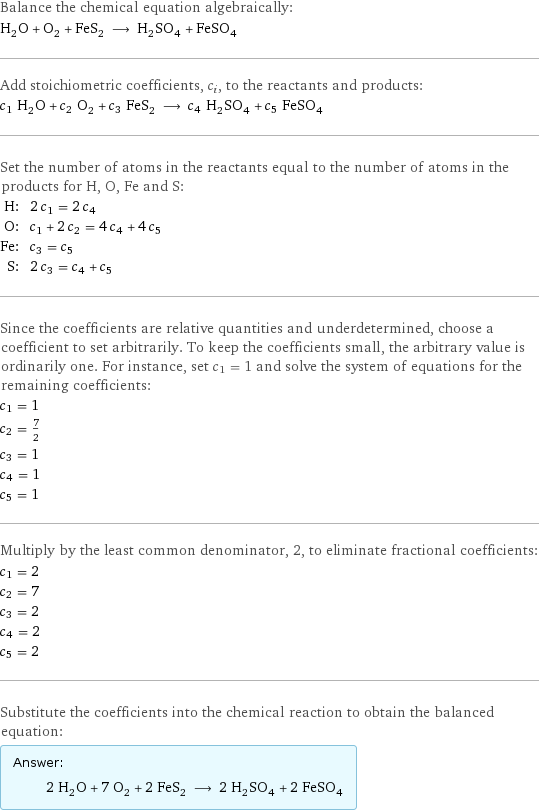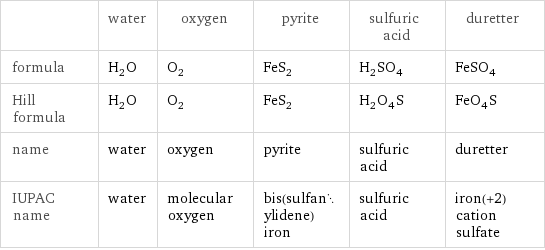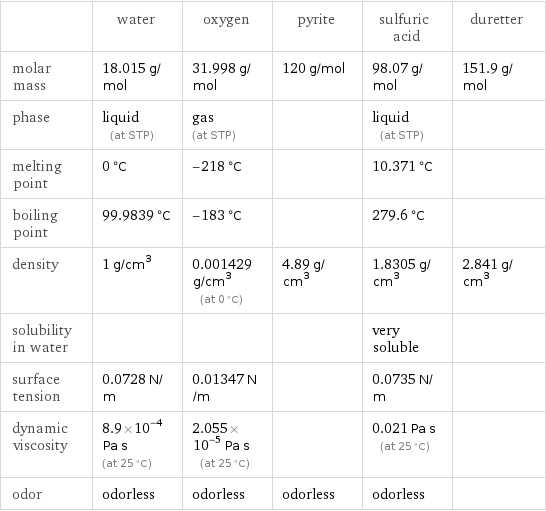Input interpretation

H_2O water + O_2 oxygen + FeS_2 pyrite ⟶ H_2SO_4 sulfuric acid + FeSO_4 duretter
Balanced equation

Balance the chemical equation algebraically: H_2O + O_2 + FeS_2 ⟶ H_2SO_4 + FeSO_4 Add stoichiometric coefficients, c_i, to the reactants and products: c_1 H_2O + c_2 O_2 + c_3 FeS_2 ⟶ c_4 H_2SO_4 + c_5 FeSO_4 Set the number of atoms in the reactants equal to the number of atoms in the products for H, O, Fe and S: H: | 2 c_1 = 2 c_4 O: | c_1 + 2 c_2 = 4 c_4 + 4 c_5 Fe: | c_3 = c_5 S: | 2 c_3 = c_4 + c_5 Since the coefficients are relative quantities and underdetermined, choose a coefficient to set arbitrarily. To keep the coefficients small, the arbitrary value is ordinarily one. For instance, set c_1 = 1 and solve the system of equations for the remaining coefficients: c_1 = 1 c_2 = 7/2 c_3 = 1 c_4 = 1 c_5 = 1 Multiply by the least common denominator, 2, to eliminate fractional coefficients: c_1 = 2 c_2 = 7 c_3 = 2 c_4 = 2 c_5 = 2 Substitute the coefficients into the chemical reaction to obtain the balanced equation: Answer: | | 2 H_2O + 7 O_2 + 2 FeS_2 ⟶ 2 H_2SO_4 + 2 FeSO_4
Structures

+ + ⟶ +
Names

water + oxygen + pyrite ⟶ sulfuric acid + duretter
Equilibrium constant
![Construct the equilibrium constant, K, expression for: H_2O + O_2 + FeS_2 ⟶ H_2SO_4 + FeSO_4 Plan: • Balance the chemical equation. • Determine the stoichiometric numbers. • Assemble the activity expression for each chemical species. • Use the activity expressions to build the equilibrium constant expression. Write the balanced chemical equation: 2 H_2O + 7 O_2 + 2 FeS_2 ⟶ 2 H_2SO_4 + 2 FeSO_4 Assign stoichiometric numbers, ν_i, using the stoichiometric coefficients, c_i, from the balanced chemical equation in the following manner: ν_i = -c_i for reactants and ν_i = c_i for products: chemical species | c_i | ν_i H_2O | 2 | -2 O_2 | 7 | -7 FeS_2 | 2 | -2 H_2SO_4 | 2 | 2 FeSO_4 | 2 | 2 Assemble the activity expressions accounting for the state of matter and ν_i: chemical species | c_i | ν_i | activity expression H_2O | 2 | -2 | ([H2O])^(-2) O_2 | 7 | -7 | ([O2])^(-7) FeS_2 | 2 | -2 | ([FeS2])^(-2) H_2SO_4 | 2 | 2 | ([H2SO4])^2 FeSO_4 | 2 | 2 | ([FeSO4])^2 The equilibrium constant symbol in the concentration basis is: K_c Mulitply the activity expressions to arrive at the K_c expression: Answer: | | K_c = ([H2O])^(-2) ([O2])^(-7) ([FeS2])^(-2) ([H2SO4])^2 ([FeSO4])^2 = (([H2SO4])^2 ([FeSO4])^2)/(([H2O])^2 ([O2])^7 ([FeS2])^2)](../image_source/ea67ae5376262ae3d81a453619beed92.png)
Construct the equilibrium constant, K, expression for: H_2O + O_2 + FeS_2 ⟶ H_2SO_4 + FeSO_4 Plan: • Balance the chemical equation. • Determine the stoichiometric numbers. • Assemble the activity expression for each chemical species. • Use the activity expressions to build the equilibrium constant expression. Write the balanced chemical equation: 2 H_2O + 7 O_2 + 2 FeS_2 ⟶ 2 H_2SO_4 + 2 FeSO_4 Assign stoichiometric numbers, ν_i, using the stoichiometric coefficients, c_i, from the balanced chemical equation in the following manner: ν_i = -c_i for reactants and ν_i = c_i for products: chemical species | c_i | ν_i H_2O | 2 | -2 O_2 | 7 | -7 FeS_2 | 2 | -2 H_2SO_4 | 2 | 2 FeSO_4 | 2 | 2 Assemble the activity expressions accounting for the state of matter and ν_i: chemical species | c_i | ν_i | activity expression H_2O | 2 | -2 | ([H2O])^(-2) O_2 | 7 | -7 | ([O2])^(-7) FeS_2 | 2 | -2 | ([FeS2])^(-2) H_2SO_4 | 2 | 2 | ([H2SO4])^2 FeSO_4 | 2 | 2 | ([FeSO4])^2 The equilibrium constant symbol in the concentration basis is: K_c Mulitply the activity expressions to arrive at the K_c expression: Answer: | | K_c = ([H2O])^(-2) ([O2])^(-7) ([FeS2])^(-2) ([H2SO4])^2 ([FeSO4])^2 = (([H2SO4])^2 ([FeSO4])^2)/(([H2O])^2 ([O2])^7 ([FeS2])^2)
Rate of reaction
![Construct the rate of reaction expression for: H_2O + O_2 + FeS_2 ⟶ H_2SO_4 + FeSO_4 Plan: • Balance the chemical equation. • Determine the stoichiometric numbers. • Assemble the rate term for each chemical species. • Write the rate of reaction expression. Write the balanced chemical equation: 2 H_2O + 7 O_2 + 2 FeS_2 ⟶ 2 H_2SO_4 + 2 FeSO_4 Assign stoichiometric numbers, ν_i, using the stoichiometric coefficients, c_i, from the balanced chemical equation in the following manner: ν_i = -c_i for reactants and ν_i = c_i for products: chemical species | c_i | ν_i H_2O | 2 | -2 O_2 | 7 | -7 FeS_2 | 2 | -2 H_2SO_4 | 2 | 2 FeSO_4 | 2 | 2 The rate term for each chemical species, B_i, is 1/ν_i(Δ[B_i])/(Δt) where [B_i] is the amount concentration and t is time: chemical species | c_i | ν_i | rate term H_2O | 2 | -2 | -1/2 (Δ[H2O])/(Δt) O_2 | 7 | -7 | -1/7 (Δ[O2])/(Δt) FeS_2 | 2 | -2 | -1/2 (Δ[FeS2])/(Δt) H_2SO_4 | 2 | 2 | 1/2 (Δ[H2SO4])/(Δt) FeSO_4 | 2 | 2 | 1/2 (Δ[FeSO4])/(Δt) (for infinitesimal rate of change, replace Δ with d) Set the rate terms equal to each other to arrive at the rate expression: Answer: | | rate = -1/2 (Δ[H2O])/(Δt) = -1/7 (Δ[O2])/(Δt) = -1/2 (Δ[FeS2])/(Δt) = 1/2 (Δ[H2SO4])/(Δt) = 1/2 (Δ[FeSO4])/(Δt) (assuming constant volume and no accumulation of intermediates or side products)](../image_source/2c92a0adc99794107ddd58bd94385b1a.png)
Construct the rate of reaction expression for: H_2O + O_2 + FeS_2 ⟶ H_2SO_4 + FeSO_4 Plan: • Balance the chemical equation. • Determine the stoichiometric numbers. • Assemble the rate term for each chemical species. • Write the rate of reaction expression. Write the balanced chemical equation: 2 H_2O + 7 O_2 + 2 FeS_2 ⟶ 2 H_2SO_4 + 2 FeSO_4 Assign stoichiometric numbers, ν_i, using the stoichiometric coefficients, c_i, from the balanced chemical equation in the following manner: ν_i = -c_i for reactants and ν_i = c_i for products: chemical species | c_i | ν_i H_2O | 2 | -2 O_2 | 7 | -7 FeS_2 | 2 | -2 H_2SO_4 | 2 | 2 FeSO_4 | 2 | 2 The rate term for each chemical species, B_i, is 1/ν_i(Δ[B_i])/(Δt) where [B_i] is the amount concentration and t is time: chemical species | c_i | ν_i | rate term H_2O | 2 | -2 | -1/2 (Δ[H2O])/(Δt) O_2 | 7 | -7 | -1/7 (Δ[O2])/(Δt) FeS_2 | 2 | -2 | -1/2 (Δ[FeS2])/(Δt) H_2SO_4 | 2 | 2 | 1/2 (Δ[H2SO4])/(Δt) FeSO_4 | 2 | 2 | 1/2 (Δ[FeSO4])/(Δt) (for infinitesimal rate of change, replace Δ with d) Set the rate terms equal to each other to arrive at the rate expression: Answer: | | rate = -1/2 (Δ[H2O])/(Δt) = -1/7 (Δ[O2])/(Δt) = -1/2 (Δ[FeS2])/(Δt) = 1/2 (Δ[H2SO4])/(Δt) = 1/2 (Δ[FeSO4])/(Δt) (assuming constant volume and no accumulation of intermediates or side products)
Chemical names and formulas

| water | oxygen | pyrite | sulfuric acid | duretter formula | H_2O | O_2 | FeS_2 | H_2SO_4 | FeSO_4 Hill formula | H_2O | O_2 | FeS_2 | H_2O_4S | FeO_4S name | water | oxygen | pyrite | sulfuric acid | duretter IUPAC name | water | molecular oxygen | bis(sulfanylidene)iron | sulfuric acid | iron(+2) cation sulfate
Substance properties

| water | oxygen | pyrite | sulfuric acid | duretter molar mass | 18.015 g/mol | 31.998 g/mol | 120 g/mol | 98.07 g/mol | 151.9 g/mol phase | liquid (at STP) | gas (at STP) | | liquid (at STP) | melting point | 0 °C | -218 °C | | 10.371 °C | boiling point | 99.9839 °C | -183 °C | | 279.6 °C | density | 1 g/cm^3 | 0.001429 g/cm^3 (at 0 °C) | 4.89 g/cm^3 | 1.8305 g/cm^3 | 2.841 g/cm^3 solubility in water | | | | very soluble | surface tension | 0.0728 N/m | 0.01347 N/m | | 0.0735 N/m | dynamic viscosity | 8.9×10^-4 Pa s (at 25 °C) | 2.055×10^-5 Pa s (at 25 °C) | | 0.021 Pa s (at 25 °C) | odor | odorless | odorless | odorless | odorless |
Units
